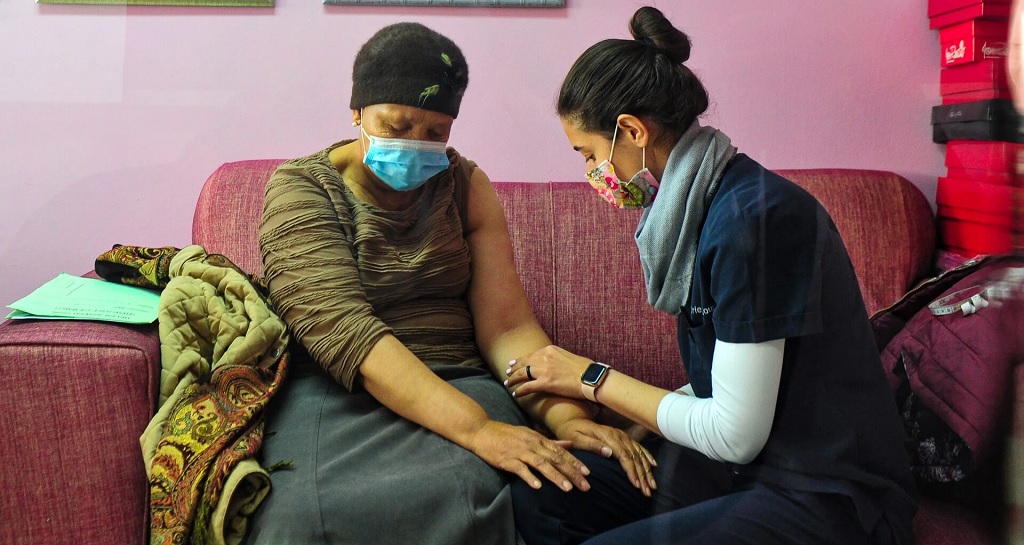Attempts Underway to Fix Gap in SA’s Plan to Fight Cancer

By Chris Bateman
Experts say cancer patients in the public sector in South Africa are dying for avoidable reasons like dysfunctional referral systems and a lack of medical imaging and treatment. We look at efforts to get the country’s battle with cancer back on track.
Many people with cancer in Gauteng have not been able to access the treatment and care they require in recent years. Though activists and the provincial government are at odds about what should, or should have been, done about it, nobody is denying that there is a problem.
At the same time, there have also been issues at a national level, with South Africa’s key cancer strategy having lapsed. The National Cancer Strategic Framework for South Africa 2017 – 2022 was previously extended to also cover 2023. Medical Brief recently reported that a new strategy is on the verge of being signed by the Director-General of Health.
The committee meant to advise the minister on cancer has also lapsed. Dr Busisiwe Ndlovu, the top government official in charge of non-communicable diseases (NCDs), said that the term of the Ministerial Advisory Committee on Cancer expired in early 2024, and new members were pending the approval of Health Minister Dr Aaron Motsoaledi. She was speaking at the KwaZulu-Natal leg of a cancer research and innovation strategy workshop in May. These consultative meetings are taking place across the country’s provinces. It aims to shape a national research and innovation strategy based on the World Health Organization’s cancer control pillars: prevention, early detection and diagnosis, treatment, and palliative care and survivorship.
The scale of the problem
While researchers anticipate that rates of infectious diseases like HIV and tuberculosis in South Africa will decline in the coming decade or two, rates of NCDs, including diabetes and cancers, are expected to increase. According to the WHO, an estimated one in five people will develop some form of cancer in their lifetimes. Increases in developing countries are expected to be particularly steep.
According to a StatsSA report published in 2023, and based on National Cancer registry (NCR) numbers and StatsSA’s mortality data, cancer-related deaths in the country increased by 29% from 2008 to 2018. They reported that 85 000 people were diagnosed with cancer in 2019 and that 44 000 died of cancers in 2018. Experts previously told Spotlight that the estimate of cancer cases may be an undercount of as much as 40%.
The most common cancers in men were prostate, colorectal, and lung – around one in four cancer diagnoses in men were for prostate cancer. Bronchus and lung cancer accounted for just under 19% of cancer-related deaths in men, while prostate cancer accounted for around 17%.
Among women, the most diagnosed cancers were breast cancer at around 23% of diagnoses and cervical cancer at around 16% of diagnoses. Cervical cancer accounted for just under 18% of all cancer deaths in women and breast cancer for 17%.
The NCR recorded 87 853 new laboratory-confirmed cancer cases in 2023, although this figure likely underestimated the true burden as it excluded clinically or radiologically diagnosed cancers, Dr Judith Mwansa-Kambafwile, senior epidemiologist with the NCR told attendees at the Durban workshop.
In a paper published in the South African Journal of Oncology in 2022, researchers calculate that cancer incidence (new cases per year) in South Africa could double from around 62 000 in 2019 to 121 000 in 2030. This is due to two factors: firstly, South Africa’s population is aging and cancers generally become more common as people age. And secondly, the risk of cancers is generally increasing for people of all ages. The researchers focused on only the five most common types of cancer, but an NCR report shows a very wide variety of cancers are being diagnosed in the country.
Since not all cancers are diagnosed, the real numbers are likely substantially higher than reported. There is also no single repository of all cancer diagnoses in the country – for the above quoted article researchers used both data from Discovery Health Medical Scheme and from the NCR.
The data gap
Cancer statistics in South Africa has been largely based on pathology results, which is to say blood or biopsies that were tested in the lab. Other types of diagnoses, such as those based on symptoms and scans have not always been counted systematically. One recent initiative aimed at addressing this data gap is a patient-led registry that feeds information into the NCR.
Mwansa-Kambafwile, explained that the NGO, Living with Cancer, was driving the patient-led registry, aimed at cross referencing and supplementing patient records with her NCR’s own patient database. Leaflets in oncologists’ reception rooms encouraged patients to upload their pathology/histology test results onto the Living with Cancer website via a standard online National Department of Health form. A national shopping mall campaign in May was aimed at boosting awareness.
“Living with Cancer had a Memorandum of Understanding with us and in addition, links cancer survivors with the same type of cancer to one another in support groups online where they can share experiences and knowledge,” she added.
Dr Mazvita Muchengeti, who heads up work on the NCR at the National Health Laboratory Services which is part of the National Institute for Communicable Diseases (NICD), previously told Spotlight that cancer was made a reportable disease under the National Health Act in 2011. While compulsory reporting has improved data on cancer cases, she added: “There is an increase in the number of reported cancers; this does not necessarily translate to an increase in cancer, we are just counting cancer cases better because reporting is now compulsory.”
Another new strategy
In light of the country’s cancer burden, a group of organisations is leading the development of a new National Cancer Research and Innovation Strategy. This collective includes the Nuclear Medicine Research Infrastructure at the University of Pretoria, the South African Medical Research Council, and the Department of Science, Technology and Innovation, in partnership with the National Department of Health.
They are hosting provincial workshops to help understand the current state of cancer research in South Africa, identify key challenges, set national priorities, and develop a strong, future-focused strategy. These workshops are part of a broader plan to make sure the strategy is inclusive, based on evidence, and meets the country’s needs.
This research and innovation strategy differs from the health department’s National Cancer Strategic Framework, which guides provinces as to what the cancer priorities are.
‘Integrated cancer care approach’
At the Durban workshop, Ndlovu, emphasised the need for an integrated cancer care approach across all levels of the healthcare system. She noted the importance of streamlined referral pathways and urgent attention to waiting times, care packages, registry improvements, and financing. The expired national cancer strategy required urgent evaluation and revision, Ndlovu added.
A clear pattern emerging from these workshops is one whereby cancers are often diagnosed too late, and patients frequently struggle to access timely, appropriate care.
Also at the Durban workshop, Professor Jeannette Parkes, Head of Radiation Oncology at Groote Schuur Hospital and the University of Cape Town, outlined the many systemic barriers to early detection. These included socio-cultural factors, urban-rural divides, and broken referral systems.
“We have a massive issue with accessing imaging services, biopsy support, pathology services, and their costs,” she said.
Parkes, who is also President of the College of Radiation Oncology of South Africa and clinical director of the Access to Care Cape Town programme, said early cancer detection was better in the private sector because patients could access and afford the necessary systems and diagnostic technology. The remaining 85% of the population depended on the public sector, in particular overburdened primary healthcare clinics but also on all levels of care.
“There’s a bias towards urban versus rural areas and too often a failure to refer. The referral pathway is problematic and differs from province to province and in various settings. We have a massive issue with regards to accessing imaging services, while biopsy support and pathology services and their costs are also a big issue,” she told the workshop.
Late diagnosis
At the Johannesburg meeting, late diagnosis was singled out as a particular problem when it comes to cervical cancer. Dr Mary Kawonga, public health specialist with the Gauteng Department of Health and Wits School of Public Health, said that 16% of women screened at Charlotte Maxeke Academic Hospital’s drainage district had pre-cancerous lesions, underlining the lack of preventative care. “Patients often only begin treatment on their sixth visit,” she said, citing the failure of diagnostic tools, referral inefficiencies, and poor implementation of available technologies.
Dr Mariza Vorster, Head of Nuclear Medicine at the University of KwaZulu-Natal and Inkosi Albert Luthuli Academic Hospital, said that insufficient specialists and excessive patient loads result in unacceptable turnaround times for diagnosis.
Clinicians often get blamed for delays, but as Dr Sheynaz Bassa, Head of Radiation Oncology at Steve Biko Academic Hospital, pointed out, many patients wait weeks or months to afford transport to care facilities. “By the time they get to us, they’re already in crisis mode,” she said. “Peripheral clinics and hospitals must improve referral systems before we can make real progress.”
Salomé Meyer, Director of Cancer Alliance, alleged that survivorship care is almost entirely absent in both the public and private sectors. “Supportive and palliative care often ends when treatment stops. Survivors are left without co-ordinated care,” she said.
Apart from improving screening and referral systems, other recommendations emerging from the workshops included better coordination between clinicians and the NCR, leveraging mobile technology like the health department’s Mom Connect app to reduce clinic visits and fast-track referrals. Greater community involvement in setting research priorities, using mobile clinics to conduct cancer screening in rural areas, and increasing awareness for breast self-examination. More research into the genetic factors relating to cancers in South Africa was also argued for.
Call for new cancer institute
Meyer has been leading a call for South Africa to establish a National Cancer Institute (NCI).
“An NCI would develop clear guidelines on treatment protocols, workforce allocation, and facility requirements,” she said. With South Africa transitioning toward a National Health Insurance system, Meyer said an NCI would help plan resource allocation based on cancer projections, enabling smarter investments in infrastructure, technology, and staffing.
The lapsed National Cancer Strategic Framework lacked province-specific detail, leaving provinces to adapt guidelines as they saw fit, often leading to fragmented service delivery, she added. Meyer said decentralisation was essential. “We can no longer restrict cancer treatment to tertiary hospitals. Many district and regional facilities could provide diagnostics and some treatments if properly resourced,” she said.
A reset of South Africa’s disease monitoring and research infrastructure has been on the cards for some time. The NICD was set to be replaced by the new National Public Health Institute of South Africa (NAPHISA) after the NAPHISA Act became law in 2020. Five years later, NAPHISA has not yet been established. On the face of it, NAPHISA would be a natural home for an entity like the proposed NCI were it to be created.
– Additional reporting by Marcus Low
Republished from Spotlight under a Creative Commons licence.
Read the original article.







